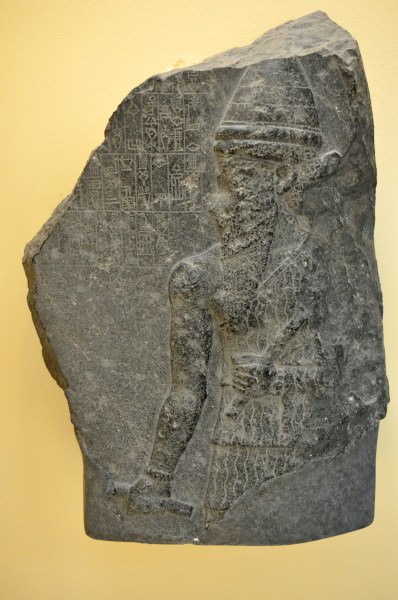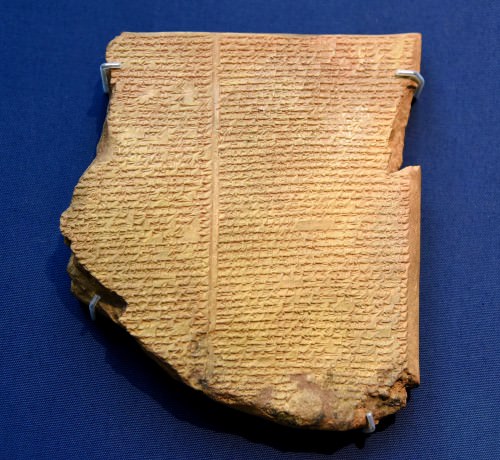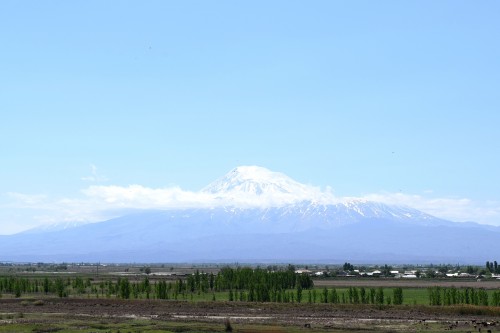Mesopotamian Naru Literature › Mount Ararat » Ancient origins
Articles and Definitions › Contents
- Mesopotamian Naru Literature › Antique Origins
- Mount Ararat › Antique Origins
Ancient civilizations › Historical and archaeological sites
Mesopotamian Naru Literature › Antique Origins
Definition and Origins

Mesopotamian Naru Literature was a literary genre, first appearing around the 2nd millennium BCE, which featured a famous person (usually a king) from history as the main character in a story that most often concerned humanity's relationship with the gods. These stories became very popular and, in time, seem to have replaced the actual historical events in the minds of the people. Two examples of naru literature - The Legend of Sargon, which came to be accepted as the king's authentic autobiography, and The Curse of Agade, dealing with Sargon's grandson Naram-Sin - were so completely accepted as authentic history that even the great scholar LW King wrote of them as such in his 1910 CE work, A History of Sumer and Akkad. The stories that comprised naru literature were highly entertaining and, because they centered on well-known figures from the past, were instantly engaging. The names of the great Akkadian kings were well known throughout Mesopotamia all the way down from Sargon's reign (2334-2279 BCE) to the fall of the Assyrian Empire in 612 BCE. The copies of such stories found at sites such as Nineveh and Mari attest to their popularity in ancient Mesopotamia, and it is highly unlikely that the ancient people who heard them gave a thought as to whether they were historically true accounts; they were simply good stories with an important message.
NARU LITERATURE DID NOT RELATE WHAT ACTUALLY HAPPENED BUT CREATED A TALE OF WHAT COULD HAPPEN IF ONE DID NOT RECOGNIZE ONE'S PROPER PLACE IN THE UNIVERSE AND BEHAVE ACCORDINGLY.
The scholar OR Gurney defines naru literature in his work The Cuthaean Legend of Naram-Sin :
A naru was an engraved stele, on which a king would record the events of his reign; the characteristic features of such an inscription are a formal self-introduction of the writer by his name and titles, a narrative in the first person, and an epilogue usually consisting of curses upon any person who might in the future deface the monument and blessings upon those who should honour it. The so-called "naru literature" consists of a small group of apocryphal naru-inscriptions, composed probably in the early second millennium BC, but in the name of famous kings of a bygone age. A well-known example is the Legend of Sargon of Akkad. In these works the form of the naru is retained, but the matter is legendary or even fictitious (93).
Scholars disagree whether such stories should rightly be called "naru literature" or "fictitious autobiography". Whichever term one uses, the works purposefully represent themselves as first-person accounts of an event of significance from which an audience is supposed to learn some important information, whether the "truth" of historical events, a religious moral, or simply some lesson which was thought useful to those hearing the tales. The term "naru literature" comes from "naru" which is explained by scholar Gerdien Jonker:
The word naru is used as a name for various objects, originally boundary stones, memorial stones and monuments. Two sorts of inscribed objects received the designation naru at the dawn of the second millennium: tablets accompanying presents and tablets used for building inscriptions. At the end of the third millennium the naru chiefly played a part in religious transactions; at the beginning of the second millennium it was to become not only actually but also symbolically the bearer of memory (90).
Inscriptions on stele and buildings was long a practice of the Mesopotamian kings by the time naru literature developed. The earliest form of writing in Mesopotamia (c. 3500-3000 BCE) was pictograms – symbols that represented objects – which served as memory aids. They helped in remembering such things as how much grain had gone to which destination or how many sheep were needed for events like sacrifices in the temples. These pictographs were impressed onto wet clay which was then dried, and these became official records of commerce. When writing moved from pictograms to phonograms, literature became possible. The kings could now record the glory of their reigns for posterity and, of course, did so. The king's inscriptions always focused on the gods and the monarch's own great deeds and addressed either a deity or a distant future audience. Naru literature took the form of the earlier naru inscriptions and changed them into stories that concerned the king's relationship with the gods and his people and were addressed to a contemporary audience. Regarding this, Gerdien Jonker writes:
There are a few differences to be mentioned between the naru monuments and the literary genre deriving from them: a. The intention of the objects was chiefly communication between god and man; in the literary genre the speaker exclusively addresses other people. b. In the first case the text was written on an object (statue, stele, building, building tablet, etc); in the second, the writer only pretends that the text is written on an object (95).

Stele of the Akkadian king Naram-Sin
The best example of this is the 2nd millennium BCE tale, The Legend of Cutha, featuring Naram-Sin (which is naru literature) as contrasted with an actual naru inscription. The story of Naram-Sin is told in the style of an inscription but deviates significantly. The following are the opening lines of a naru inscription by King Lugalzagesi (reigned c. 2350 BCE) who was Sargon of Akkad's predecessor:
Lugalzagesi, king of Uruk,
king of the nation,
incantation-priest of An,
lumah-priest of Nisaba,
son of UU, the ruler of Umma
and lumah-priest of Nisaba,
looked upon truly
by An as the king of all the lands.
The opening of The Legend of Cutha, on the other hand, begins thusly:
Open the tablet box and read the stelethat I, Naram-Sin, descendant of Sargoninscribed and left behind for posterity.The king of Uruk disappeared.Enmerkar disappeared.Enmerkar, king of Uruk, ruler of the land[Some period of time] passed.[Some period of time] went by.
The naru inscriptions relate the story of the king's reign and triumphs; the naru literature often tells the story of the king's struggles and failure, even if the events never happened. In The Legend of Cutha, for example, Naram-Sin is faced with an invading hoard of seemingly super-human creatures. When he asks the gods for advice in opposing them, he is told that he should do nothing. He ignores the will of the gods, however, and decides to rely on his own judgment. He sends out a massive military force that is slaughtered by the invaders and does so two more times before he realizes he is doing something wrong in the eyes of the gods since, clearly, they are not favoring his cause. He humbles himself, seeks their guidance, and learns that the gods had plans to destroy the invaders themselves and did not need, nor want, Naram-Sin's interference. He comes to understand that one should trust the will of the gods instead of following the counsel of one's own heart. The poem ends with Naram-Sin directly addressing future rulers, telling them to trust the gods, heed the message of his story, and not make the same mistakes that he did. This is quite a different kind of story than those of kings like Lugalzagesi (and Naram-Sin's actual inscriptions) that told only of the great accomplishments of their reigns, their military campaigns, and temples and cities built by their decree. The naru literature was not interested in relating what actually did happen but in creating a tale of what could have happened - and what could happen again in the present - if one did not recognize one's proper place in the universe and behave accordingly. Gerdien Jonker writes:
What mattered in the naru literature was the retaining of memory, condensed into the enduring name of the "sender". It was also a matter of preserving one's own memory, of making oneself live on in the form of one's own name, which was bound up with the memory of one's own deeds. Names had to resound because people wished for them to be invoked after death (96).
Since the naru literature is largely anonymous, the writers must have staked their immortality on the popularity of their tales without needing to attach their names to their work (although it is entirely possible they did so and the original tablets have simply been lost). When Jonker writes above about "the retaining of memory", it should be recognized that it was not necessarily the memory of what had happened in the past that was important to the writers of the naru literature but that there had been a past worth remembering. Jonker states, "It should be made clear that the ancient writers were not aiming to deceive with their literary creations" (95). They were instead trying to preserve their past in a form that they felt could help people in the present. An inscription of the great deeds of a king who conquered many cities and slaughtered many people was fine for that particular king but not much use to the people who lived under him. Naru literature, on the other hand, provided the people with entertaining stories they could learn from, remember, and make use of in their daily lives as they remembered the lessons of the past.
Mount Ararat › Antique Origins
Definition and Origins

Mount Ararat (Armenian: Masis; Turkish: Ağrı Dağı; Kurdish: Çiyaye Agiri; Azeri: Ağrıdağ) is a dormant, compound volcanic mountain, consisting of two ancient volcanic peaks, located in present-day eastern Turkey very close to the border with Armenia. Strongly associated with Armenian culture, mythology, and identity, Mt. Ararat is also where, according to some legends, Noah's Ark landed after the biblical flood.
GEOGRAPHY
Located roughly halfway between Lake Van to the southwest in Turkey and Lake Sevan to the northeast in Armenia, the Ararat Mountains dominate the Armenian Highlands. The Ararat Mountains are located within the southern end of the Ararat Plain, and they thus create a fertile agricultural zone with a temperate climate. Together, the Ararat Mountains straddle the borders of what are present-day Turkey, Armenia, Iran, and Azerbaijan. Mt. Ararat (“Greater Ararat”) rises to a height of 5,137 m (16,854 ft). Mt. Ararat's neighboring mountain, Little Ararat (“Ararat the Lesser”) rises upwards to 3,925 m (12,877 ft). Mt. Ararat and Little Ararat are the highest and sixth highest points in Turkey. On a clear day, both can be seen from downtown Yerevan, Armenia, which is 54 km (33 mi) away from Mt. Ararat. The monastery Khor Virip additionally affords stunning views of the Ararat Mountains from Armenia.
THE SUMERIANS, AKKADIANS, & ASSYRIANS EACH BELIEVED THAT MT. ARARAT WAS NOT ONLY THE HOME OF THEIR GODS, BUT ALSO THE SOURCE OF THEIR CIVILIZATIONS.
ANCIENT MYTHS & LEGENDS
In ancient times, successive Mesopotamian peoples regarded the mountains as sacred, but they were also wary of the fierce, local inhabitants. The Sumerians, Akkadians, and Assyrians each believed that Mt. Ararat was not only the home of their gods, but also the source of their civilizations, as the waters of the Tigris and Euphrates Rivers flowed downwards from the mountain to fertilize the lands adjacent to their cities and settlements. Assyrian texts, in particular, praise the holiness and majesty of the mountains, describing them as a place where “heavenly birds cannot reach.”
Mesopotamians, however, also associated the mountains with the fierce tribes that inhabited Mt. Ararat's slopes; regularly, they raided Mesopotamian villages and settlements. Another perceived danger associated with Mt. Ararat was that of disastrous flooding. Sumerians, Akkadians, and Babylonians each had their own flood account, but they all in turn referenced the Mountains of Ararat as the place in which their respective heroes found refuge after surviving torrential rains and perilous waters. An ancient Akkadian tale from the 3rd millennium BCE delineates the exploits of a man called “Utnapishti” who became immortal and survived a catastrophic flood by landing his vessel upon the tallest mountains in the north of his country.Gilgamesh, the celebrated Sumerian hero, reached a northerly mountain called “Mashu,” which was the location through which the sun rose and set every day.

Flood Tablet of the Epic of Gilgamesh
Ancient Armenians called the mountain “Azatn Masis,” which meant “holy” and “free” in the Old Armenian language. Kajs, which were guardian spirits of royal and noble families, dwelled on Greater Ararat. Pagan Armenians found it taboo to scale the mountains as they believed, much like the Sumerians, that Mt. Ararat was the place where the sun came to rest during the night. Even after their conversion to Christianity, Armenians were still reluctant to risk climbing to Mt. Ararat's peak. There is, nevertheless, a legend that King Trdat III, Armenia's first Christian king, climbed Mt. Ararat to bring down stones for the foundations of eight new churches.
MYTHS & LEGENDS ARE STRONGLY CORRELATED WITH THE VOLCANIC STEAM, ASH, & BLACK WATERS THAT SPEWED FORTH OUT OF MT. ARARAT.
Armenians have many myths and legends about the base of the Ararat Mountains, many of which predate Christianity, and include dragons, snakes, and other reptilian monsters. These myths and legends are strongly correlated with the volcanic steam, ash, and black waters that spewed forth out of Mt. Ararat during eruptions and earthquakes. Movses Khorenatsi (c. 410-490s CE), an Armenian historian and the author of the History of Armenia, wrote that Armenians are the direct descendants of Noah through his son Japheth, and that Haik, the mythical founder of Armenia and ancestor to all Armenians, established his nation within the vicinity of Mt. Ararat.
MT. ARARAT IN SCRIPTURAL & HISTORICAL TEXTS
There is much historical speculation as to when and how the biblical story of Noah and the great flood first became associated with Mt. Ararat. Some linguists contend that “Ararat” is merely a variation of “ Urartu,” which was the leading ancient polity to the north of Assyria during the Iron Age. The Hebrew Book of Jubilees composed around c. 100 BCE, related that Noah's Ark was located on "Mount Lubar" in "the land of Ararat." (Jubilees 5.28, 10.15). The Jewish historian Flavius Josephus (37-100 CE) used the "Ararat" to denote a mountain south of Lake Van, but he subsequently attested traditions that Noah's Ark came to rest on "Mount Baris." (Jewish Antiquities 1.93)

Mount Ararat
In ways similar to the older Mesopotamian myths and legends, the Bible references the Mt. Ararat in Genesis 8.4 in relation to the story of Noah:
...And the ark rested in the seventh month, and on the seventeenth day of the month, upon the mountains of Ararat.
The Qu'ran is explicit in naming the mountain upon which Noah's ark landed as “Mt. Judi” and not Mt. Ararat:
A voice cried out: 'Earth, swallow up your waters. Heaven, cease your rain'. The floods abated and His will was done. The ark came to rest upon al-Judi, and a voice declared: 'Gone are the evil-doers'. (11:43)
The Arab geographer Ibn Khordadbeh (c. 820-912 CE) and the Arab historian Abu al-Hasan 'Ali al-Masudi (c. 896-956 CE) both asserted that the ark came to rest in in "Assyria", not too far from one of the sources of the Tigris River.
Previously it was thought by some historians that the presence of Jews in Armenia's Araxes Valley might have provided the catalyst in the reassociation of Mt. Ararat with Noah's Ark, but this assertion seems improbable. Just like historians throughout early medieval Europe (c. 400-1000 CE), early Armenian historians opined that the biblical Ararat was located in the ancient province of Corduene (Armenian: Korduk), situated to the southeast of Lake Van. Today this area is part of modern Turkey, and close to the source of the Tigris River and the city of Cizre. The arrival of European crusaders and intermarriage between Armenians and European crusaders in the 11th and 12th century CE seem to have accelerated the reassertion that Mt. Ararat was the spot where the Ark came to land. When Europeans returned to continental Europe from the Holy Land or Armenia, they reiterated that Mt. Ararat, located in the heart of Armenia, was where the ark could be found.
ASSOCIATION WITH ARMENIAN PEOPLE & CULTURE
For thousands of years, the Armenian people have utilized the Ararat Mountains as emblems of their national and cultural identity. Appearing frequently in modern material culture - on everything from t-shirts and bumper stickers to wooden sculptures and necklaces - Mt. Ararat has also graced Armenian currency, stamps, and its three coats of arms since 1918 CE.Although Armenians see Mt. Ararat as a symbol for their deep losses and tragedies in the 20th century CE as it currently lies within the borders of Turkey, they also view the mountains as intricately connected to their faith, religious beliefs, and artistic traditions.
This article was made possible with generous support from the National Association for Armenian Studies and Researchand the Knights of Vartan Fund for Armenian Studies.
LICENSE:
Article based on information obtained from these sources:with permission from the Website Ancient History Encyclopedia
Content is available under License Creative Commons: Attribution-NonCommercial-ShareAlike 3.0 Unported. CC-BY-NC-SA License